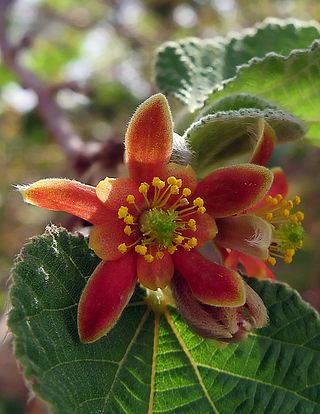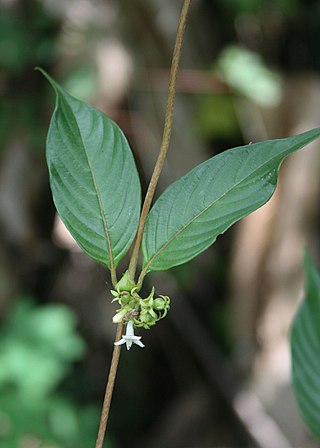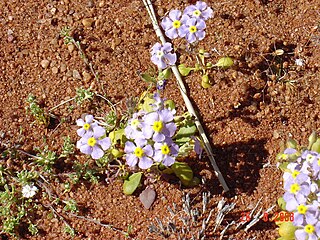
Mentha is a genus of plants in the family Lamiaceae. The exact distinction between species is unclear; it is estimated that 13 to 24 species exist. Hybridization occurs naturally where some species' ranges overlap. Many hybrids and cultivars are known.

Syringa is a genus of 12 currently recognized species of flowering woody plants in the olive family or Oleaceae called lilacs. These lilacs are native to woodland and scrub from southeastern Europe to eastern Asia, and widely and commonly cultivated in temperate areas elsewhere.

Jasmine is a genus of shrubs and vines in the olive family of Oleaceae. It contains around 200 species native to tropical and warm temperate regions of Eurasia, Africa, and Oceania. Jasmines are widely cultivated for the characteristic fragrance of their flowers. Additionally a number of unrelated species of plants or flowers contain the word "jasmine" in their common names.

Althaea is a genus of herbaceous perennial plants native to Europe, North Africa and western Asia. It includes Althaea officinalis, also known as the marshmallow plant, whence the fluffy confection got its name. They are found on the banks of rivers and in salt marshes, preferring moist, sandy soils. The stems grow to 1–2 m tall, and flower in mid summer. The leaves are palmately lobed with 3–7 lobes. Althaea species are used as food plants by the larvae of some Lepidoptera species including Bucculatrix quadrigemina.

Grewia villosa is a shrub, often scrambling and hardly exceeding 4 m in height. Leaves are fairly large, serrated and heart-shaped. It grows naturally, mainly in dry habitats. It is common in most of the semi-arid parts of Eastern Africa but may now be rare in parts of its natural distribution. It can be seen in Ein Gedi oasis in Israel, and in South Africa, where it is common. Its ripe copper-coloured fruits are eaten in East Africa.

Artemisia afra, the African wormwood,[4] is a common species of the genus Artemisia in Africa, with a wide distribution from South Africa, to areas reaching to the North and East, as far north as Ethiopia. Artemisia afra is the only species in this genus indigenous to the African continent.

Pteronia is a genus of evergreen, woody perennial plants assigned to the family Asteraceae with currently 76 described species. Like in almost all Asteraceae, the individual flowers are 5-merous, small and clustered in typical heads, surrounded by an involucre of bracts. In Pteronia, the centre of the head is taken by relatively few, yellow, disc florets, while a ring of ligulate florets is absent. These florets sit on a common base.

Sabicea is a genus of flowering plants in the family Rubiaceae. They are known commonly as the woodvines. The type species is Sabicea cinerea. There are about 145 species. Most are distributed in tropical Africa and South America.

Strumaria is a genus of African plants in Amaryllis family, subfamily Amaryllidoideae. The genus is known in nature only from South Africa, Lesotho and Namibia. Almost all species flower in the autumn and are cultivated as ornamental bulbous plants.

Serruria, or spiderhead is a genus of flowering plants in the family Proteaceae, endemic to South Africa.

Galactia is a genus of plants in the legume family (Fabaceae). It belongs to the subfamily Faboideae and tribe Diocleae They do not have an unambiguous common name, being commonly called milk peas, beach peas or wild peas. They are perennial herbs or subshrubs with prostrate, climbing, or erect forms.

Zaluzianskya is a genus of flowering plants now regarded as being a member of the Scrophulariaceae, the figwort family. The genus is endemic to Southern Africa and includes some described sixty species.

Pteronia paniculata is a species of flowering plant in the family Asteraceae, indigenous to the Karoo regions of South Africa.

Pteronia pallens is a species of flowering plant in the family Asteraceae, indigenous to the Karoo regions of South Africa. Its natural habitat is dry, rocky slopes. It often cooccurs with its close relatives, Pteronia paniculata or Pteronia incana.

Pteronia incana is a species of flowering plant in the family Asteraceae, indigenous to the Karoo regions of South Africa.
Pteronia glauca ("Geelboegoekaroo") is a species of flowering plant in the family Asteraceae, indigenous to the Karoo regions of South Africa.
Pteronia oppositifolia is a species of flowering plant in the family Asteraceae, indigenous to the western Little Karoo and Overberg regions in the Cape Provinces of South Africa.

Serruria villosa, the golden spiderhead, is a flower-bearing shrub that belongs to the genus Serruria and forms part of the fynbos. The plant is native to the Western Cape, where it occurs only on the Cape Peninsula and just south of Constantia. The shrub is erect and grows only 50 cm tall and bears flowers from April to July.
Hermas is a genus of flowering plant in the family Apiaceae, native to Cape Provinces of South Africa.



















